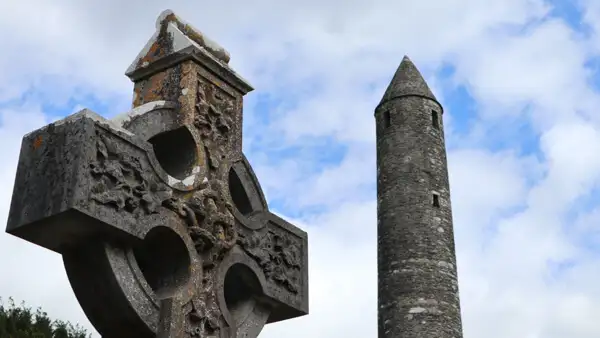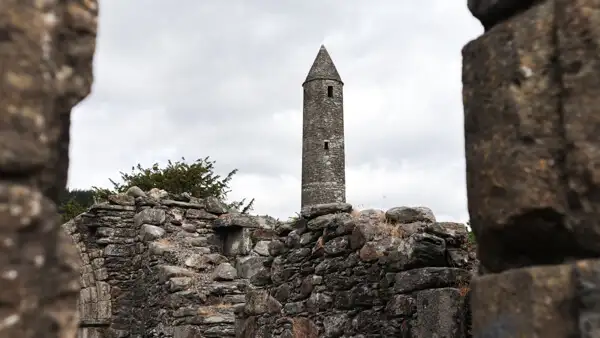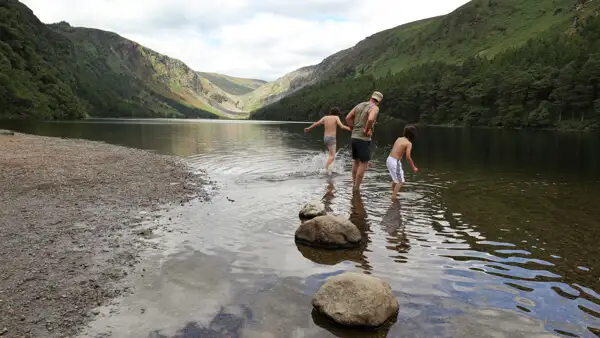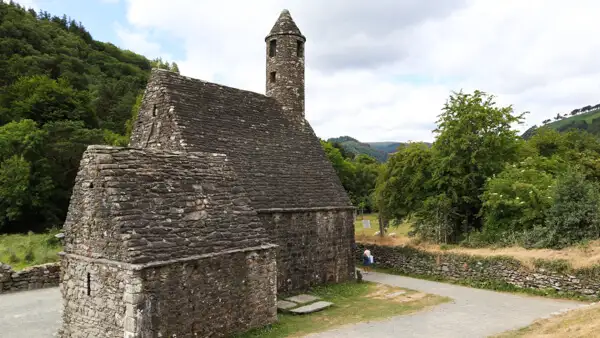Even if you’re not normally interested in monasteries – you have to have been here! And if you are interested in medieval monasteries? Then even more so!
Page Contents (click line to jump the text)

Intro
That was a rather grandiose announcement, but Glendalough is actually one of the most important highlights in Ireland’s Ancient East and is visited by numerous tourists every year.
Glendalough is located in the beautiful Wicklow Mountain National Park, just an hour’s drive south of Dublin. You can combine a visit to Glendalough with a beautiful drive through the Wicklow Mountains and easily combine this with your journey to or from Dublin Airport.
Ireland’s Ancient East is the historic east of Ireland. In a wide semi-circle around Dublin, the so-called “The Pale”, there are a large number of important historical sights in Ireland.

Glendlough Monastic City was founded in the 6th century. The monastery that is visible today dates mainly from the 10th-12th centuries and is quite well preserved. A special feature is the round tower, typical of Ireland, which is still completely intact.
The old monastery is situated in an almost mystically beautiful landscape in a valley with two lakes framed by high mountains. The name Glen-da-lough comes from the Gaelic (the Irish call it “Irish”) and means valley of the two lakes.
History of the Monastic City of Glendalough
If you consciously take in the valley of Glendalough, you may instinctively feel that this is a special place. Many people do. You may even feel a kind of mysticism or the power of nature or some other spiritual attraction.
There are such special places in nature. These have always been special places or even sanctuaries in ancient religions that were still very close to nature. Sacred sites were erected here, be it wooden poles, buildings or dolmens made of large boulders. This is where people met for their religious rituals and where the shamans of the Bronze Age, the Celtic druids and later the Christian monks and priests who took over these places for themselves preached.

The peace probably did not last long, as more and more followers followed his example and a centre of faith and a school of the Irish-Scottish Church was established here.
The monastery was probably built gradually in the 7th century and was continually expanded.
In the 9th century, the Vikings plundered many monasteries in Ireland, including Glendalough. The typical round towers with their high entrance doors, which could only be reached by ladders, were apparently used to protect the monks and the church treasures. a kind of early medieval bank, so to speak. The beautiful 30 metre high round tower in Glendalough was built in the 10th century.
But despite several raids, the Monastic City of Glendalough continued to thrive. There were up to 7 churches in the valley and around the 12th century there were probably more than 3000 people living here. Nobles from all over Europe sent their sons to Glendalough for ecclesiastical education and study. The monastery became one of the most important ecclesiastical educational establishments in Ireland and Europe.
In the 14th century, the monastery was destroyed by Anglo-Normans. However, it was partially rebuilt and existed as a monastery until 1539, when all Irish monasteries were closed by Henry VIII of England.
Today’s monastery is manageable in size, there are still some smaller buildings, which are mainly churches or chapels. There are nice guided tours with guides, which I can highly recommend – just ask at the Visitor Centre.
Today, St Kevin’s Day is still celebrated here on 3 June. Pilgrims from all over Ireland gather here for this occasion.

Hiking in Glendalough
The monastery is beautiful, but the beautiful valley is worth at least as much attention. It is a glacial valley surrounded by high mountain walls. The two lakes in the valley are thus picturesquely framed like mountain lakes.
There are several well-signposted hiking trails, some of which lead out of the valley and up the mountain slopes. Probably the best known is the Spinc Trail, which leads up the mountain at Poulanass Waterfall and around the valley. On the other side, the trail goes through an old mine and past both lakes.
I have hiked most of the trails myself and always find them beautiful, especially the Spinc Trail. I have hiked in the Wicklow Mountains many times, including in the neighbouring valley of Glenmalure.
We live in the southeast of Ireland (second home), not very far from Glendalough. We are originally from Germany.
If you’re not a keen hiker or don’t have much time, there are also short, easy circular trails to the lake. You can get a map of all the trails at the Glendalough Visitor Centre, see: https://glendalough.ie/heritage/glendalough-visitor-centre/.

Eat, drink and stay in Glendalough
There are several hotels, B&Bs and restaurants in Glendalough and in Laragh, the neighbouring village. You’ll have no problem finding somewhere to stay. You can also find B&Bs in the surrounding area, as the Wicklow Mountains are a holiday destination for hikers. You can find more information here: https://visitwicklow.ie/location/laragh-glendalough/?listing_category=eat-drink-stay.
Conclusion
I’m not very spiritually inclined, but even for me Glendalough is a magical place and I always enjoy coming here.
In summer, however, day-trip buses from Dublin also come here and many Dublin families are out and about in the Wicklow Mountains, especially at weekends.
So if I were you, I would go to Glendalough as early or late in the day as possible in summer. Or even better: I would visit the Monastic City in spring, autumn or winter, when it’s less busy.
However, if you come here on a sunny Sunday lunchtime in summer, you can shorten your visit to the Monastic City and then quickly switch to one of the hiking trails.
As soon as you have walked a little way from the car park, it becomes much quieter and you can enjoy the wonderful mountains in peace and quiet and look down on the magical valley of the two lakes from above.
Have a great day in Glendalough!
More interesting articles for you
WEXFORD – SO OLD – SO NEW!
WATERFORD AND THE VIKINGS
THE MEDIEVAL TOWN OF KILKENNY
THE LEGENDARY ROCK OF CASHEL
Picture credits cover picture: Glendalough Monastic City, photo by Ulrich Knüppel-Gertberg (www.irland-insider.de, www.ireland-insider.com)